How to Improve Cold Email Response Rates: The Complete 2025 Guide
Proven tactics to boost your cold email replies and grow your pipeline
Playbooks & Inspirationby JanJune 09, 2025

Picture this: You send 1,000 carefully crafted cold emails. Only 20 people reply. That's a 2% response rate – and for many sales teams, that's their reality.
But what if you could get 50 or even 100 replies from those same 1,000 emails? That's not wishful thinking. Top performers consistently achieve 5-10% response rates using specific, repeatable tactics.
The difference between a 2% and 10% response rate isn't luck. It's method. After analyzing thousands of cold emails and their results, we've identified exactly what separates high-performing campaigns from the rest.
This guide reveals 12 proven methods that consistently improve cold email response rates, backed by real data and practical examples you can implement today.
What Really Drives Cold Email Response Rates in 2025
Cold email response rates have changed dramatically. Generic templates that worked five years ago now get ignored or marked as spam. Today's prospects receive 100+ emails daily and have developed sophisticated filters for what deserves their attention.
Three factors determine whether your cold email gets a response:
Relevance: Does your message address a real problem they're facing right now?
Credibility: Do you demonstrate understanding of their specific situation?
Clarity: Can they understand your value proposition in under 10 seconds?
Most cold emails fail because they're built on assumptions rather than insights. They talk about features instead of outcomes. They focus on what the sender wants rather than what the recipient needs.
The highest-performing cold emails share one trait: they feel like they were written by someone who genuinely understands the recipient's world.
The Psychology Behind Why Prospects Actually Reply
The Trust Factor
People don't reply to strangers – they reply to people who demonstrate credibility. This credibility comes from showing specific knowledge about their industry, company, or role.
When you reference their recent product launch, mention a challenge specific to their market, or acknowledge their company's unique position, you transform from "random salesperson" to "someone who gets it."
Timing and Relevance
Response rates spike when your outreach aligns with active priorities. A CFO planning next year's budget thinks differently than one who just closed the books. A startup that just raised funding has different needs than one extending their runway.
Timing isn't just about when you send – it's about when your message arrives relative to their current challenges and initiatives.
The Value Exchange
Every response requires effort. Your prospect must believe that responding will provide more value than the time it takes. This means offering insights, connections, or solutions – not just requesting a meeting.
The best cold emails give value first, then ask for something small in return.
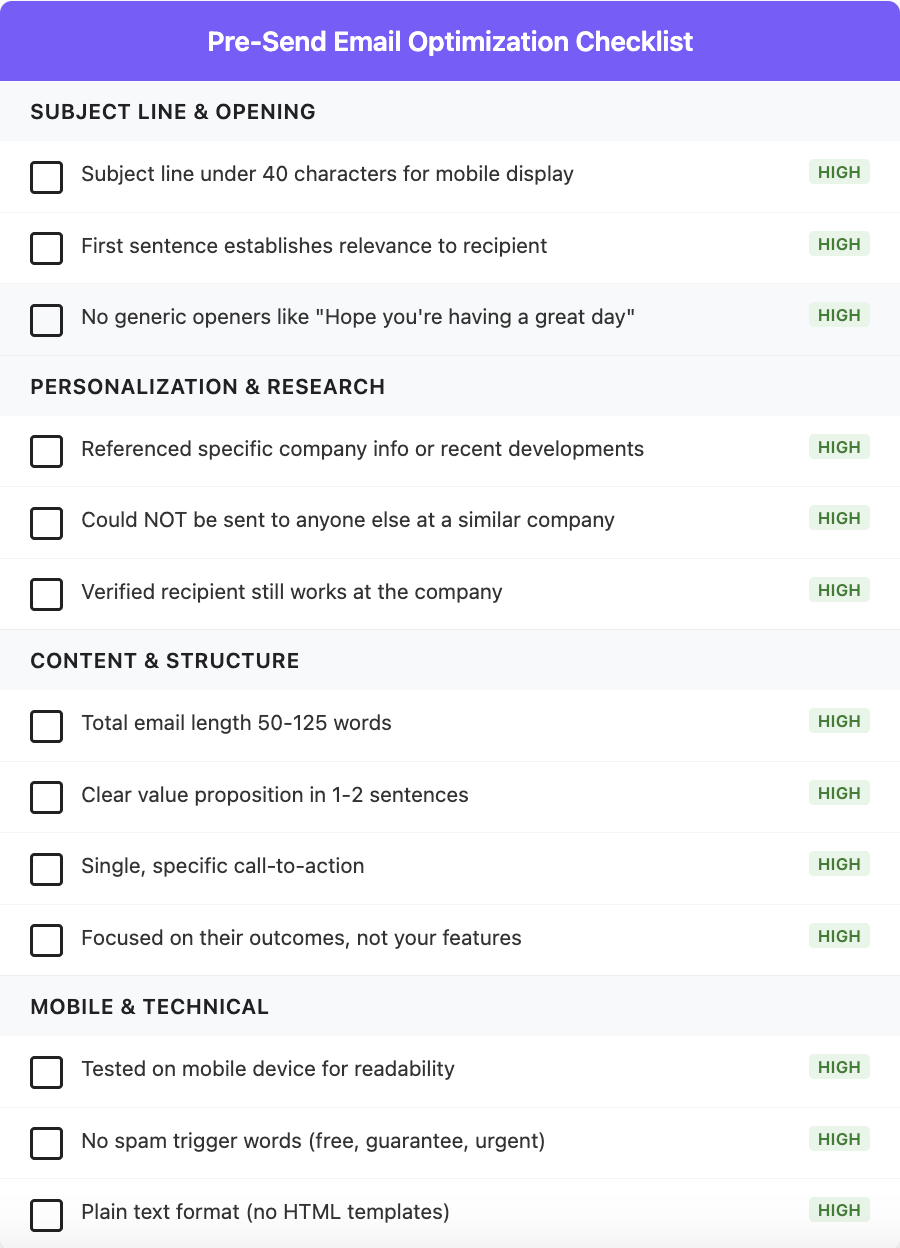
12 Proven Methods to Improve Your Cold Email Response Rates
1. Master the Subject Line
Your subject line determines whether your email gets opened. But opening isn't the goal – response is. The best subject lines create curiosity while maintaining credibility.
What works in 2025:
- Questions that hint at value: "Quick question about [specific initiative]"
- Specific references: "Re: Your LinkedIn post about [topic]"
- Mutual connections: "[Name] suggested I reach out"
What doesn't work:
- False urgency: "Last chance!"
- Generic benefits: "Increase your revenue"
- Misleading subject lines that don't match email content
Subject lines under 40 characters get the highest response rates. They display fully on mobile devices and force you to be specific rather than vague.
2. Write Shorter, More Focused Emails
The ideal cold email length is 50-125 words. This isn't arbitrary – it's based on how people actually read emails.
Long emails signal high effort to process. Short emails respect your prospect's time and increase the likelihood they'll read to your call-to-action.
Here's the structure that works:
- Opening (1-2 sentences): Establish relevance
- Value proposition (1-3 sentences): Explain what's in it for them
- Call-to-action (1 sentence): Make it easy to respond
Every sentence should earn its place. If removing a sentence doesn't hurt your message, it shouldn't be there.
3. Perfect Your Email Timing
When you send matters less than sending when your prospect is actually working. A perfectly timed email to someone on vacation gets the same response as a poorly timed one – none.
Recent data shows these patterns:
- Tuesday through Thursday: Highest response rates
- 10-11 AM and 2-3 PM in prospect's timezone: Peak engagement
- Avoid Mondays: Inbox overload from the weekend
- Skip Fridays: Mental checkout for many professionals
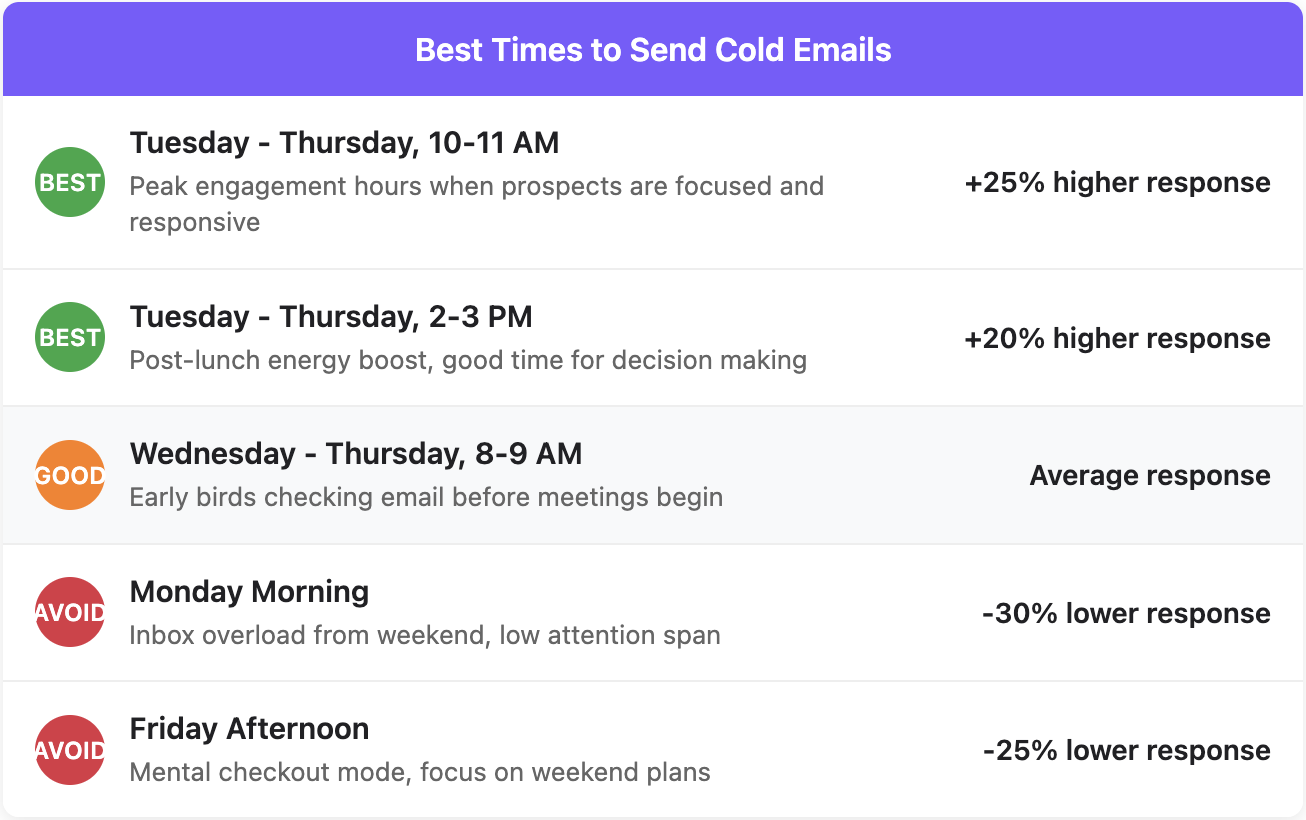
But individual patterns matter more than averages. Track when your specific prospects engage with content on LinkedIn or publish blog posts. Active online presence correlates with email responsiveness.
4. Create a Clear Value Proposition
Your value proposition should be understood in one reading. Complex explanations kill response rates because they require too much mental effort to process.
Focus on outcomes, not features:
- Wrong: "Our platform has advanced analytics capabilities"
- Right: "See exactly which campaigns drive revenue"
Connect your value to their specific situation. Generic benefits get ignored. Specific, relevant benefits get responses.
5. Add Genuine Personalization
Personalization isn't just mail merge. Using someone's name and company isn't personalization – it's basic courtesy.
Real personalization demonstrates research and understanding:
- Reference specific content they've created
- Mention recent company developments
- Connect your solution to their stated goals
- Acknowledge industry-specific challenges
The test: Could this email be sent to anyone else at a similar company? If yes, it's not personalized enough.
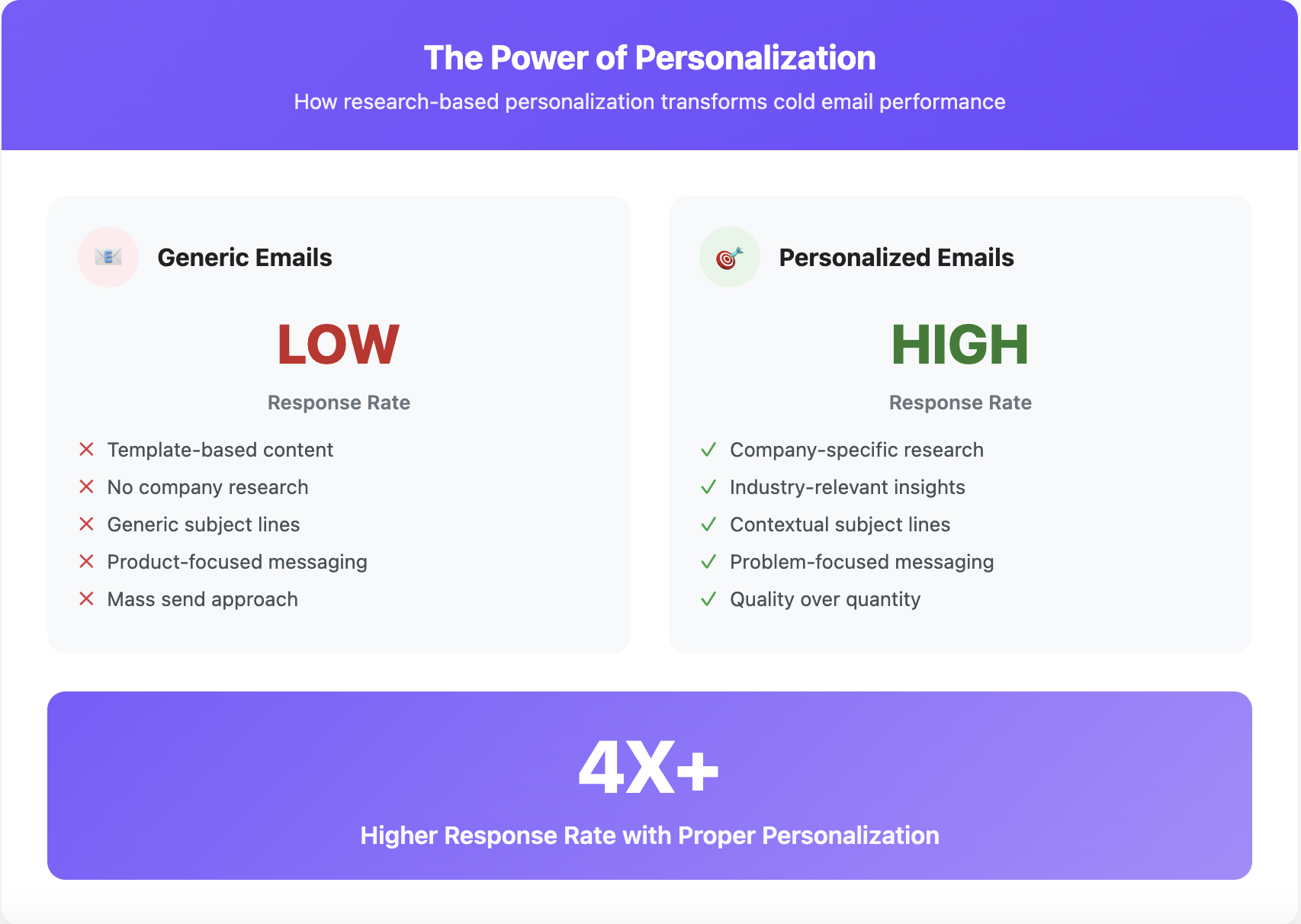
6. Use Pattern Interrupts
Standard sales emails follow predictable patterns. Breaking these patterns captures attention and increases responses.
Pattern interrupts that work:
- Admitting what you don't know: "I'm not sure if this is a priority for you right now..."
- Starting with a question: "Quick question - are you still using [specific tool]?"
These techniques work because they feel more human and less scripted.
7. Implement Smart Follow-Up Sequences
Many responses come from follow-ups, not first emails. Yet most salespeople give up after one or two attempts.
The optimal follow-up sequence:
- Email 1: Initial outreach
- Email 2 (3 days later): Add new information or insight/Different angle or approach
- Email 3 (5 days later): Final value-add and close
Each follow-up should provide new value, not just ask again. Vary your approach – if email one was formal, try conversational. If you led with benefits, try leading with a question.
8. Optimize for Mobile Reading
65% of emails are opened on mobile devices. If your email doesn't work on mobile, you're losing two-thirds of potential responses.
Mobile optimization checklist:
- Short subject lines (under 40 characters)
- Single column layout
- Short paragraphs (2-3 lines max)
- Clear, tappable CTA buttons
- No tiny fonts or complex formatting
Test every email on your phone before sending. If it's hard to read or requires zooming, redesign it.
9. Use Social Proof Strategically
Social proof works, but only when relevant. Mentioning you work with Fortune 500 companies means nothing if your prospect is a startup.
Effective social proof mentions:
- Similar companies in their industry
- Companies of comparable size
- Businesses facing similar challenges
- Results from relevant case studies
Place social proof after your value proposition, not before. Lead with their needs, then show you can deliver.
10. Test Different Email Formats
Traditional paragraph-style emails aren't always best. Testing different formats can dramatically improve response rates.
Formats worth testing:
- Bulleted benefits: Easy to scan and process
- Question-based: Entire email as 3-4 questions
- Problem/Solution: Clear before/after scenario
- Story format: Brief narrative that resonates
Match format to your audience. Technical buyers often prefer bullet points. Creative industries may respond better to narrative formats.
11. Multi-Channel Warming Before Email Outreach
Prospects respond to people they recognize. Cold email doesn't have to be completely cold. By creating touchpoints before your email arrives, you transform from stranger to familiar name.
Pre-email warming tactics that boost response rates by 40%+:
View their LinkedIn profile 24-48 hours before emailing. When they see the notification, your name registers subconsciously.
Engage with their content strategically. Like and thoughtfully comment on their recent LinkedIn posts or company updates. Avoid generic comments – add genuine value to the discussion.
Follow their company page and engage with company content. This shows interest in their organization beyond just making a sale.
Connect with mutual connections. When prospects see shared connections, trust increases immediately.
This approach works because of the mere exposure effect – psychological research shows people develop preferences for things they encounter repeatedly. When your email arrives, you're already a familiar presence rather than an unknown sender.
12. Track and Iterate Based on Data
What gets measured gets improved. Track not just response rates but response quality and sentiment.
Key metrics to monitor:
- Response rate by subject line variation
- Response sentiment (positive/negative/neutral)
- Time to response
- Response rate by email length
- Follow-up sequence performance
Use this data to continuously refine your approach. Small improvements compound – increasing response rates from 10% to 12% means 20% more conversations.
The Follow-Up Formula That Doubles Response Rates
Most follow-ups fail because they just say "checking in" or "following up on my previous email." Effective follow-ups add value each time.
Here’s a formula that works:
Follow-up 1: Share an insight relevant to their industry
Follow-up 2: Provide a useful resource (article, tool, template)
Follow-up 3: Mention a trigger event (news, change, announcement)
Follow-up 4: Offer a different angle or approach
Follow-up 5: Graceful exit with value
Each follow-up should stand alone. Assume they haven't read previous emails. Reference your initial outreach briefly, then provide new value.
The key: Make each follow-up worth reading even if they never respond.

Common Response Rate Killers to Avoid
Using spam trigger words: "Free," "guarantee," "limited time" tank deliverability and credibility.
Leading with your pitch: Talking about your product before establishing relevance ensures deletion.
Fake familiarity: "Hope you're having a great Tuesday!" feels manipulative, not friendly.
Buried call-to-action: If they can't find what you want them to do, they won't do it.
Multiple requests: Asking for a meeting, referral, and feedback in one email guarantees none happen.
Poor data quality: Emailing people who left the company six months ago wastes everyone's time.
Template laziness: Forgetting to update {merge fields} or sending "Hey [First Name]" screams mass email.
Measuring and Benchmarking Your Response Rates
Industry averages provide context, but your baseline matters more. A 3% response rate might be excellent for enterprise software but poor for recruiting services.
Typical benchmarks by approach:
- Spray and pray (no personalization): 1-3%
- Basic personalization (name, company): 3-5%
- Advanced personalization (research-based): 5-10%
- Trigger-based outreach (timely and relevant): 5-15%
Track your response rates by:
- Industry vertical
- Company size
- Buyer persona
- Message type
- Personalization level
This data reveals which segments respond best to your approach, allowing you to focus efforts where they generate the highest return.
Advanced Tactics for Scaling Response Rates
Multi-thread outreach: Contacting multiple stakeholders at target accounts increases overall response probability while providing more entry points.
Account-based sequences: Coordinate outreach across channels (email, LinkedIn, phone) for consistent messaging that builds familiarity.
Trigger-based automation: Set up alerts for company events (funding, hiring, product launches) and automate relevant outreach within 48 hours.
Response optimization: A/B test not just subject lines but entire email frameworks, personaliation types, and value propositions.
Segmented messaging: Create distinct templates for different industries, company sizes, and buyer personas rather than forcing one message to work for all.
The Data Foundation That Powers 10%+ Response Rates
While mastering these cold email response rate strategies will significantly improve your results, there's one factor that amplifies everything else: the quality of your prospect data.
Think about it - perfect timing means nothing if you're emailing someone who left the company. Beautiful personalization falls flat when based on outdated information. Even the best subject lines can't save emails sent to invalid addresses.
This is where Databar.ai improves your cold email performance drastically.
Take Your Response Rates to the Next Level with Databar.ai
You've just learned 12 proven methods to improve cold email response rates. But implementing them effectively requires accurate, comprehensive prospect data.
Databar.ai gives you an unfair advantage:
✓ 90+ data providers in one platform - Get verified emails, phone numbers, and rich prospect insights without juggling multiple subscriptions
✓ Waterfall enrichment - Automatically check multiple sources until you find the data you need, achieving 80%+ coverage rates
✓ Real-time verification - Ensure every email reaches its target with multi-source validation
✓ Behavioral triggers - Know exactly when prospects are ready to buy based on hiring patterns, funding events, and technology adoption
✓ AI-powered personalization - Generate unique, contextual email openers based on real prospect data, not guesswork
Ready to see what 10%+ response rates look like? Start your free Databar.ai trial today and build your first enriched prospect list in minutes. No credit card required.
The path to exceptional cold email response rates isn't complicated, but it requires commitment to continuous improvement. Start with one or two tactics from this guide. Measure the results. Then add more.
Every percentage point improvement in response rate directly impacts your pipeline and revenue. The time invested in optimizing your cold email approach pays dividends for months and years to come.
Your prospects' inboxes are crowded, but they still respond to messages that demonstrate understanding, provide value, and respect their time. Apply these methods consistently, and watch your response rates – and results – transform.
Skyrocket your cold email response rates now → Get Started Free
FAQs About Improving Cold Email Response Rates
What's a realistic response rate improvement timeline? Most teams see 25-50% improvement within 30 days of implementing these tactics. Reaching optimal rates (5-15%) typically takes 60-90 days of consistent testing and refinement.
Should I use HTML templates or plain text emails? Plain text consistently outperforms HTML for cold outreach. They feel more personal, avoid spam filters, and display correctly across all devices.
How many follow-ups are too many? Three to five thoughtful follow-ups is optimal. Beyond that, response rates rarely justify the effort. Always include an unsubscribe option.
What's more important: volume or personalization? Neither extreme works well. Find your sweet spot where you can maintain quality personalization at a volume that hits your pipeline goals.
Related articles
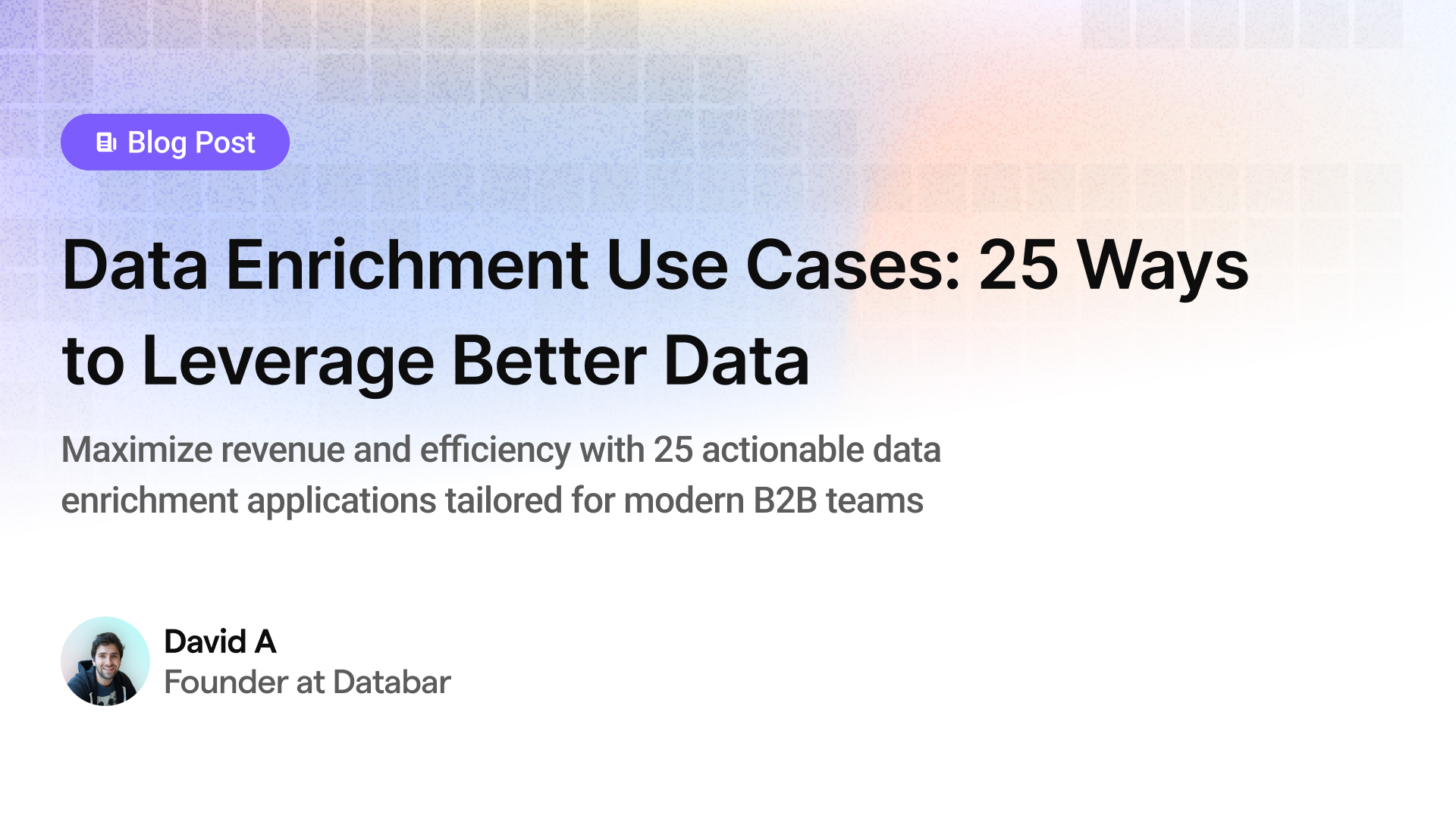
Data Enrichment Use Cases: 25 Ways to Leverage Better Data
Maximize revenue and efficiency with 25 actionable data enrichment applications tailored for modern B2B teams.
by Jan, June 29, 2025
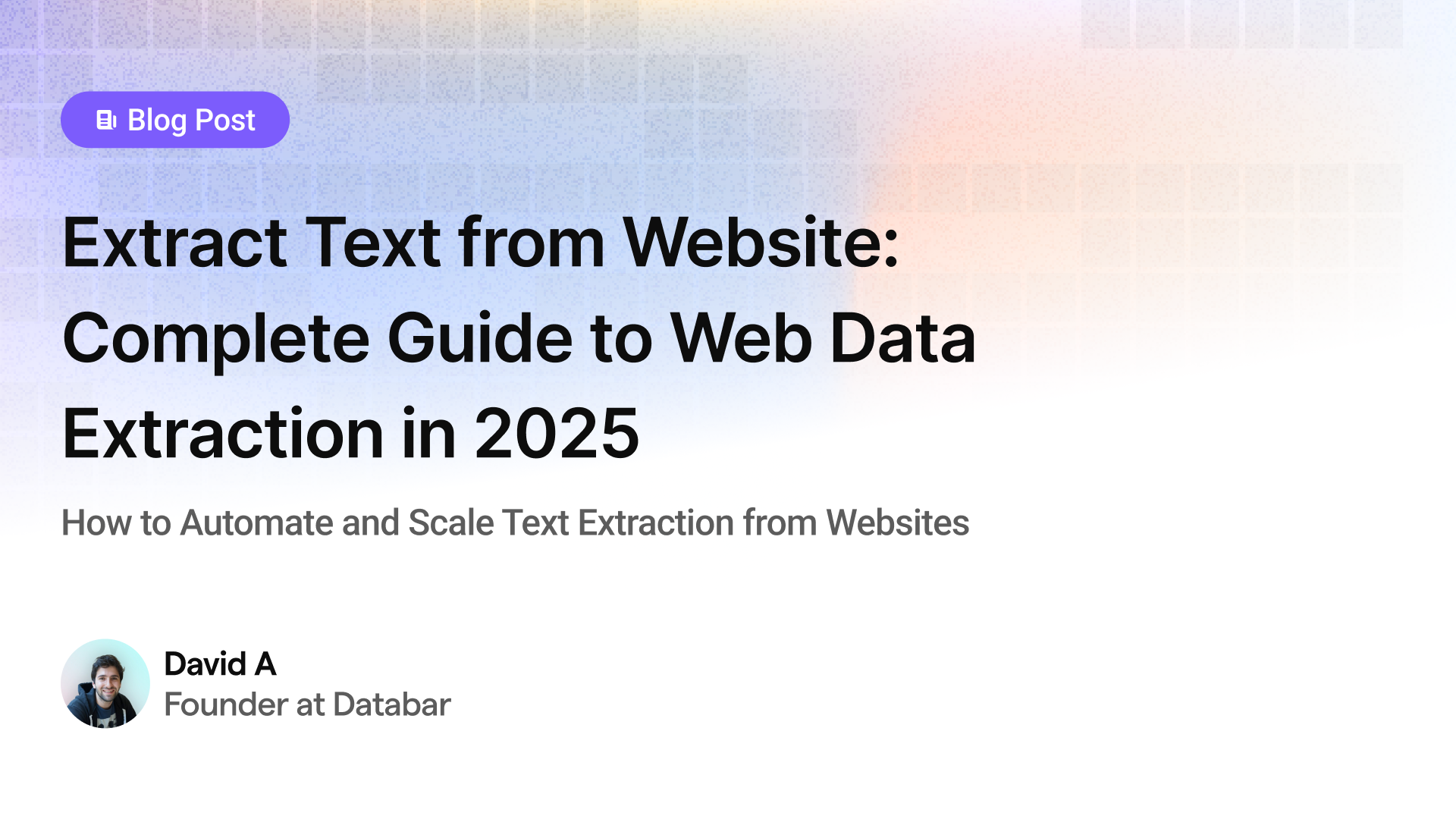
Extract Text from Website: Complete Guide to Web Data Extraction in 2025
How to Automate and Scale Text Extraction from Websites for Business Success
by Jan, June 24, 2025

How to create charts and maps with live data and no code
Create live models of your data with interactive charts and maps.
by Databar, January 22, 2023
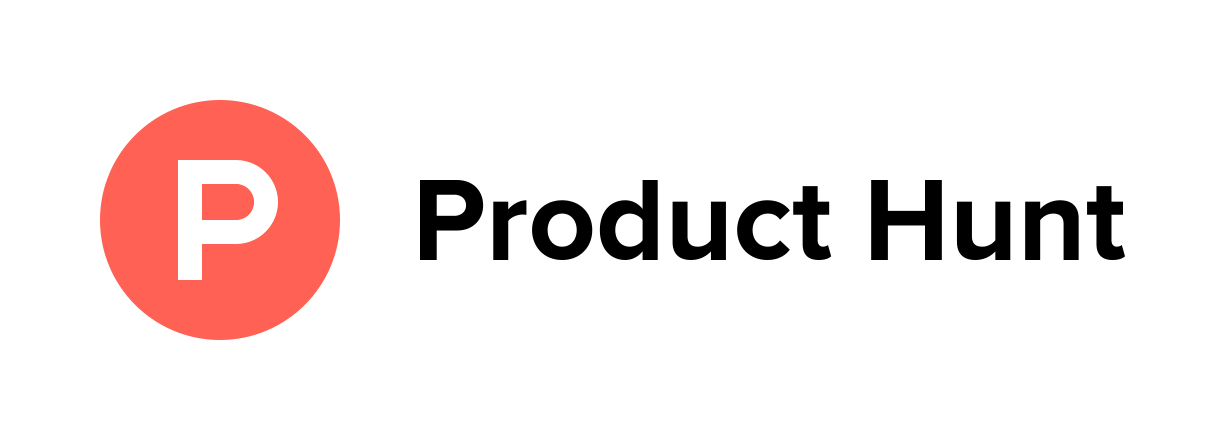
Should you launch on Product Hunt during the holidays?
We analyzed historic Product Hunt launches to find out if it's a good idea to launch during the holidays. Here's what we found.
by Databar, January 04, 2023